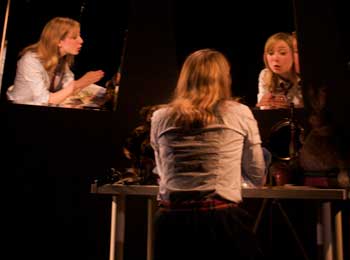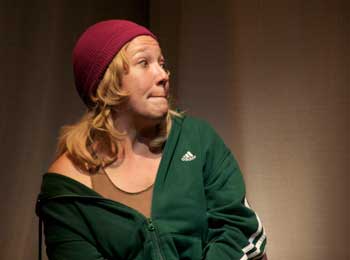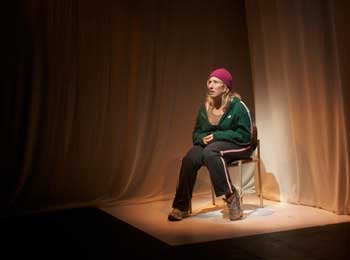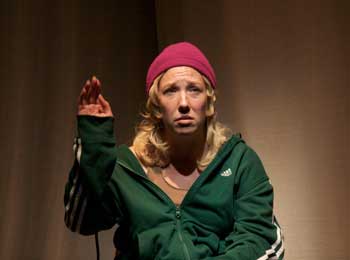World of the Plays
World of the Plays Russian playwright Yaroslava Pulinovich has written two monologues about characters named Natasha: I Won and Natasha’s Dream. Pulinovich is among the youngest voices bringing the experience of a new generation to the Russian stage. Natasha’s Dream was first seen by Moscow audiences in full production in November 2009. The companion piece, I Won, appeared before an audience for the first time in the workshop production featuring artists from Towson University’s MFA program. The Natasha Plays allow glimpses into two very different experiences of youth in contemporary Russia. Each young woman’s sense of herself in the world is shaped in large part by the environment in which she has been raised. I Won depicts the life of the middle class Natasha. Her experiences emerge from the contemporary Russian phenomena of hyper-protectiveness of parents and their drive for their childrens’ success. Natasha Dream presents a very different girl dealing with very different problems. This Natasha lives in one of Russia’s orphanages. Her story brings to life harshness of the conditions in these homes and the uncertainty of the future of orphans. The Natasha Plays provides us with contrasting visions of life for teenage women in Russia.
Parents’ Protection and
Children’s Success
The early and middle 1990s were tumultuous years for citizens of the newly formed Russian Federation. A series of political coups, the collapse of the nation’s economy and an increasingly powerful system of organized crime had devastating effects on the country. Life expectancy dropped, as did the birth rate, and some found it impossible to survive. Many of those who brought children into the world during this period were unable to provide for them, and the number of children who were homeless or relegated to state institutional care rose. But those parents who managed to provide a stable life for their young families were also marked by this drastically changing world. As the children born during this period now reach the later years of high school, social observers report new trends in parenting among people who started families in the early years of the Russian Federation and corresponding attitudes and behaviors among their offspring that distinguish many of these children, even from their slightly older peers born near the end of the Soviet Union.
In an article identifying the tendency of contemporary Russia parents to be “hyperprotective” of their children, reporter Fred Weir suggests the social, political and economic instability of the 1990s as a primary reason for this attitude. Media reports of crimes against children also seem to feed parents’ fears for their children’s safety. Marina Bityanova, head of the Tchka Psi psychological center in Moscow says that many contemporary Russian parents see the world as a potentially dangerous place for their children: “They have deep-seated fears, which they consider very well-grounded” (Weir). As a result, the children are not given much freedom and parents carefully monitor activities outside the home, such as walking to school, using public transportation or visiting their friends. According to Bityanova, “Possibly their surveillance is excessive, but this is the typical Russian reaction. Parents worry that their children may not be able to cope with all the uncertainties and dangers that are out there” (Weir). Weir notes that such attitudes seem particular to the country’s middle class, “for whom a modicum of economic well-being is a new and fragile development.”
The experiences that many parents of teenagers faced earlier in their lives may also play a significant factor in the way that they prepare their children for adulthood and in the values and life choices of those children. In 2006, the St. Petersburg Humanities University of Trade Unions and the Social Information Agency conducted a study of students in the 10th and 11th grades. These surveys found parents taking an increasingly active role in “the process of the socialization of their children, and orienting them toward life strategies and values that are more stable and less dependent on social and political changes” (8 – 9). One life strategy emphasized by many parents is the pursuit of a college degree. The value of higher education for families can be seen, among other places, in the increasing numbers of parents who are willing to pay for tutors to help prepare their children for college. Nearly 40% of the young people in the survey were studying with tutors – a practice considered crucial to one’s placement in college, even for the most academically gifted students. Such spending on education, once reserved for the elite, has now spread to a broader portion of society.
For their part, teenagers echo their parents’ attitudes about their education. In recent years, the prestige of higher education has increased among young people, and they are willing to invest in the strategies necessary to ensure educational and career opportunities. As a result, they spend a great deal of their leisure time attending special courses and taking lessons from tutors (8 – 9). Unlike their parents, who generally selected a specialization in their education, today’s teenagers have been encouraged to master a number of specialties, resulting in a broad-based education that prepares them to adapt to a changing world (10 – 11). By and large, their attention within this world seems to be focused on their personal goals and achievements, or, what scholar Aleksandr Zapesotskii calls “individually significant objectives,” rather than “socially significant objectives” (17). Unlike previous generations of Russians, these teenages express little concern for social and political problems. Instead, as Zapesotskii puts it, “high social status has been shifted into the sphere of private accomplishments and success in the private sphere: family, career, financial stability, and friendly interaction” (16).
Works Cited
Weir, Fred. “Russian Parents Make No Apologies For Being ‘Hyperprotective.’”
Christian Science Monitor. 22 May 2008. Web. 19 Jan. 2010.
Zapesotskii, A. S. “Children of the Era of Changes: Their Values and Choices.” Russian
Education and Society 49.9 (2007): 5 – 17. Academic Search Premier. Web. 20 Jan. 2010.
Robyn Quick
Russia Season Dramaturg
Russian Orphanages
Throughout the play Natasha’s Dream, by Yaroslava Pulinovich, evidence of overcrowding, abuse by staff members, and poor living conditions in Russian orphanages is unmistakable. Over the past decade, reports by human rights organizations and stories in the press have documented a series of problems in these institutions.
The precise number of besprizorniki, or homeless children, may be as high as two to five million, according to a State Committee for Statistics report. At least 800,000 of them are officially recognized by the government as orphans or “social orphans” – children with living parents who are not able to care for them due to circumstances such as illness or incarceration (Prisiazhnaia 23 – 4). Parents of children born with disabilities may also be convinced that the children should be sent to state institutions (Feifer).
According to media reports, many institutions are ill-equipped to deal with the numbers of children in their care. Some facilities can provide only one toilet for every twenty orphans (Lowry). Limited resources also lead to malnutrition among residents of some orphanages (DeLaine). The treatment of children may also be influenced by the ways in which they are classified. Children that have physical conditions such as cleft palate, speech impediment, cross eyes, or dislocated hips may be presumed to have mental defects as well. Once they are housed in orphanages, children deemed mentally impaired generally receive limited education and insufficient medical care for their needs. Those with physical disabilities that limit their mobility may be sent to “lying down” rooms, where they spend most of their time (Lowry).
While the living conditions in many orphanages may have seriously detrimental effects on the physical health and well being of their residents, the administration of those institutions marks the children’s sense of self in the world. Sociologist Margarita Astoiants studied the effect of routine daily practices in orphanages on the attitudes and behavior of residents. According to Astoiants, children in these institutions have very limited contact with the outside world and minimal sense of privacy or individuality.
Typically, the children are educated at the institution where they reside. Therefore, they have little opportunity to interact with their peers or others outside the orphanage. Astoiants reports that exceptionally good behavior or a close relationship with a staff member may result in a desired excursion outside the facility. Others attempt to connect with the world outside by running away from the orphanage. Running away is considered a serious infraction by the staff. Punishment can range from a simple reprimand, for a first offense, to time spent in an isolation facility. Further attempts to escape might lead a child to have his or her head shaved or to be treated with tranquilizers. Those residents considered the most troublesome, like those with physical disabilities, might be judged to have mental deficiencies, which could result in a transfer to a more restrictive institution and a life-long label that inhibits future educational opportunities (34 – 6).
In contrast to the isolation that may serve as a punishment for infractions such as running away from the orphanage, residents typically have minimal opportunity for privacy. In the institution that Astoiants studied, children live in rooms shared by 4 – 6 children. The doors to shared toilet facilities are generally left open. Residents take baths in groups once a week in a separate part of the institution (32 – 3). As a result of this lifestyle, they develop a sense of “social ownership” in which they come to believe that they have access to anything or anyone they encounter (25). At the same time, they crave any opportunity to express individuality or claim personal space. Female residents, in particular, try to show individuality in their clothing. Since the institution’s budget doesnot provide for cosmetics and other items associated with personal decoration, such objects are highly regarded by the orphans. They will also treasure any personal item, such as a picture from their family of origin, because little in their life provides them with any sense of a life separate from the others in the institution (37 – 8). As Astoiants puts it, “A child living in a children’s home does not have anything of his own, anything by which he might assert his existence in the world” (25).
Works Cited
Astoiants, M.S. “Orphaned Children: An Analysis of Life and Practices in a Residential Institution.”
Russian Education and Society 49. 4 (2007): 23–42. Academic Search Premier.
Web. 9 Dec. 2009.
DeLaine, Linda. Plight of Russia’s Orphans. Russian Life, 2000. Web. 16 Jan. 2010.
Feifer, Gregory. “Russia’s Halt on Adoptions Spotlights Conditions.”
NPR, 2010. Web. 16 Jan. 2010.
Lowry, Joe. “Inside Russia’s Orphanages. The Magazine of the International Red Cross
and Red Crescent Movement, 2000. Web. 16 Jan. 2010.
Prisiazhnaia, Nadezhda. “Orphan Children: Adjusting to Life After the Boarding Institution.”
Russian Education and Society. 50.12 (2008): 23–39. Academic Search Premier.
Web. 25 Jan. 2010.
Stables, Eleanor. “From Russia with Love.” The American Spectator, 2005.
Web. 16 Jan. 2010.
State Committee for Statistics. “Russia in Numbers: Every Hundredth Kid Doesn’t Have
Parents.” State Committee for Statistics Official Site: Statistika.ru. Web. 22 Jan. 2010.
(Translation: Yury Urnov).
Tim Lorch
Senior, Theatre Arts
The Journey of Russian
Orphans’ Lives
Depending on age and severity of disabilities or birth defects, orphaned children in Russia are placed in state run institutions that provide them with a place to live and receive an education. But the overcrowded facilities and limitations of staff and resources may create conditions, which affect their development in social, behavioral, physical and mental skills. For many children, the journey through this institutional system begins in maternity hospitals, where young orphaned babies may be misdiagnosed with disabilities that mark them as “untouchables” within the Russian community. If abandoned by parents at the hospitals or given over to state care through institutions, these children, as well as those whose parents are unavailable or unable to raise them for other reasons, are placed in Baby Homes. Such facilities provide locations for orphaned babies to reside and be looked after from infancy to the age of four, where they are either adopted, reunited with their parents, or transferred to Children’s Homes, or to “Internats” (“Baby” 20). These institutions provide care for orphaned children from the ages of 4 to 16 or 18 (“Baby” 22).
Children’s Homes lack the capacity to house the increasing number of orphans and therefore, once orphans reach the age of 16 to 18 they are made to leave the orphanage and begin leading their own lives. The displaced orphans go out into the world having had no experience of how to live independently or interact properly with others. The education they receive in these schools is often not equivalent to what their peers outside the institution receive. Some of these young adult orphans resort to prostitution to survive. Those who become pregnant and cannot support a child, may be left with no option but to place the child in an orphanage, thus feeding the growing cycle of “social orphans,” or orphans with a living parent in Russia. In addition to turning to prostitution for survival, young adult orphans also fall victim to alcohol and drug abuse, participate in criminal gangs, or commit suicide with very few living normal, healthy lives (Feifer). Statistics show that 40% of the orphans that leave Children Homes after coming “of age” become drug and alcohol addicts, another 40% become involved in criminal activities, 10% commit suicide and the last 10% struggle to live healthy and productive lives (Stables 1).
Works Cited
“Baby Homes in the Russian Federation.” Monographs of the Society for Research in Child
Development 73.3 (2008): 16-29. Academic Search Premier. Web. 16 Jan. 2010.
Feifer, Gregory. “Russia’s Halts on Adoptions Spotlights Conditions.” NPR Morning Edition
25 April 2007. Web. 15 Jan. 2010.
Stables, Eleanor. “From Russia with Love.” The American Spectator. 17 June 2005. Web. 15
Jan. 2010.
Emily D. Vere Nicoll
Sophomore, Theatre Arts
With additional research by
Stephanie Holland
Senior, Theatre Arts

Sarah Lloyd in I Won. Towson University. May 2010. Photo: Jay Herzog



Julia M. Smith in Natasha’s Dream. Towson University. May 2010. Photo: Jay Herzog








